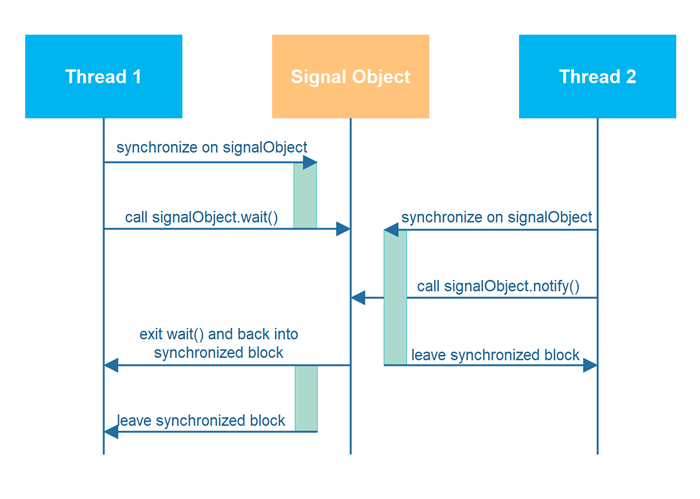Thread Signaling in Java
Jakob Jenkov |
Java contains a set of features that enable thread to send signals to each other, and for threads to wait for such signals. For instance, a thread B might wait for a signal from thread A indicating that data is ready to be processed.
The thread signaling features in Java are implemented via the wait(), notify()
and notifyAll() methods that are part of the the Object class which all Java classes extend.
Java Thread Signaling Tutorial Video
I have a video version of this tutorial here:

wait(), notify() and notifyAll()
Java has a built-in wait mechanism that enable threads to become inactive while waiting for signals from other threads. The class java.lang.Object defines three methods, wait(), notify(), and notifyAll(), to facilitate this.
A thread that calls wait() on any object becomes inactive until another thread calls notify() or notifyAll() on that object. In order to call either wait(), notify() or notifyAll(), the calling thread must first obtain the lock on that object. In other words, the calling thread must call wait() or notify() from inside a synchronized block that is synchronized on that object.
Below is an example class that can be used for two threads to pass signals. Both threads need access to the
same instance of this class. One thread will call the doWait() method, and the other thread
will call doNotify().
public class MonitorObject{
}
public class MyWaitNotify{
MonitorObject myMonitorObject = new MonitorObject();
public void doWait(){
synchronized(myMonitorObject){
try{
myMonitorObject.wait();
} catch(InterruptedException e){...}
}
}
public void doNotify(){
synchronized(myMonitorObject){
myMonitorObject.notify();
}
}
}
When the first thread calls doWait() it first enters a synchronized block and then
calls wait() on an internal monitor object. The synchronized block is synchronized
on that monitor object. When wait() is called - the calling thread releases the lock
on the monitor object - and is blocked until another thread calls notify() or
notifyAll() on the monitor object.
When the second threads calls doNotify() it enters a synchronized block that is
synchronized on the internal monitor object. Inside this synchronized block the thread then
calls the notify() method on the monitor object. This will wake up one thread
blocked inside a wait() call on the same monitor object. However, none of these
awakened threads can exit the wait() method until the thread calling
notify() (or notifyAll()) has released the lock on the monitor
object.
After calling notify() the second thread exits the synchronized block,
which enables the awakened thread or threads to exit the wait() call and enter
back into the synchronized block - which they then shortly after exit.
The above principle and process is illustrated below. Note, that the diagram refers to the monitor object as "signal object" - meaning the object through which the thread send signals.

Multiple threads can call wait() on the same monitor object - and thus
become blocked waiting for a notify() or notifyAll() call.
Calling notify() will only awaken a single waiting thread.
Calling notifyAll() will awaken all waiting threads.
A thread cannot call wait(), notify() or notifyAll() without holding the synchronization lock on the object the method is called on. If it does, an IllegalMonitorStateException is thrown.
Missed Signals
The methods notify() and notifyAll() do not save the method calls to them in case no threads are waiting when they are called. The notify signal is then just lost. Therefore, if a thread calls notify() before the thread to signal has called wait(), the signal will be missed by the waiting thread. This may or may not be a problem, but in some cases this may result in the waiting thread waiting forever, never waking up, because the signal to wake up was missed.
To avoid losing signals they should be stored inside the signal class. In the MyWaitNotify example the notify signal should be stored in a member variable inside the MyWaitNotify instance. Here is a modified version of MyWaitNotify that does this:
public class MyWaitNotify2{
MonitorObject myMonitorObject = new MonitorObject();
boolean wasSignalled = false;
public void doWait(){
synchronized(myMonitorObject){
if(!wasSignalled){
try{
myMonitorObject.wait();
} catch(InterruptedException e){...}
}
//clear signal and continue running.
wasSignalled = false;
}
}
public void doNotify(){
synchronized(myMonitorObject){
wasSignalled = true;
myMonitorObject.notify();
}
}
}
Notice how the doNotify() method now sets the wasSignalled variable to true before calling notify(). Also, notice how the doWait() method now checks the wasSignalled variable before calling wait(). In fact it only calls wait() if no signal was received in between the previous doWait() call and this.
Spurious Wakeups
For inexplicable reasons it is possible for threads to wake up even if notify() and notifyAll() has not been called. This is known as spurious wakeups. Wakeups without any reason.
If a spurious wakeup occurs in the MyWaitNofity2 class's doWait() method the waiting thread may continue processing without having received a proper signal to do so! This could cause serious problems in your application.
To guard against spurious wakeups the signal member variable is checked inside a while loop instead of inside an if-statement. Such a while loop is also called a spin lock. The thread awakened spins around until the condition in the spin lock (while loop) becomes false. Here is a modified version of MyWaitNotify2 that shows this:
public class MyWaitNotify3{
MonitorObject myMonitorObject = new MonitorObject();
boolean wasSignalled = false;
public void doWait(){
synchronized(myMonitorObject){
while(!wasSignalled){
try{
myMonitorObject.wait();
} catch(InterruptedException e){...}
}
//clear signal and continue running.
wasSignalled = false;
}
}
public void doNotify(){
synchronized(myMonitorObject){
wasSignalled = true;
myMonitorObject.notify();
}
}
}
Notice how the wait() call is now nested inside a while loop instead of an if-statement. If the waiting thread wakes up without having received a signal, the wasSignalled member will still be false, and the while loop will execute once more, causing the awakened thread to go back to waiting.
Multiple Threads Waiting for the Same Signals
The while loop is also a nice solution if you have multiple threads waiting, which are all awakened using notifyAll(), but only one of them should be allowed to continue. Only one thread at a time will be able to obtain the lock on the monitor object, meaning only one thread can exit the wait() call and clear the wasSignalled flag. Once this thread then exits the synchronized block in the doWait() method, the other threads can exit the wait() call and check the wasSignalled member variable inside the while loop. However, this flag was cleared by the first thread waking up, so the rest of the awakened threads go back to waiting, until the next signal arrives.
Don't call wait() on constant String's or global objects
An earlier version of this text had an edition of the MyWaitNotify example class which used a constant string ( "" ) as monitor object. Here is how that example looked:
public class MyWaitNotify{
String myMonitorObject = "";
boolean wasSignalled = false;
public void doWait(){
synchronized(myMonitorObject){
while(!wasSignalled){
try{
myMonitorObject.wait();
} catch(InterruptedException e){...}
}
//clear signal and continue running.
wasSignalled = false;
}
}
public void doNotify(){
synchronized(myMonitorObject){
wasSignalled = true;
myMonitorObject.notify();
}
}
}
The problem with calling wait() and notify() on the empty string, or any other constant string is, that the JVM/Compiler internally translates constant strings into the same object. That means, that even if you have two different MyWaitNotify instances, they both reference the same empty string instance. This also means that threads calling doWait() on the first MyWaitNotify instance risk being awakened by doNotify() calls on the second MyWaitNotify instance.
The situation is sketched in the diagram below:

|
Remember, that even if the 4 threads call wait() and notify() on the same shared string instance, the signals from the doWait() and doNotify() calls are stored individually in the two MyWaitNotify instances. A doNotify() call on the MyWaitNotify 1 may wake threads waiting in MyWaitNotify 2, but the signal will only be stored in MyWaitNotify 1.
At first this may not seem like a big problem. After all, if doNotify() is called on the second MyWaitNotify instance all that can really happen is that Thread A and B are awakened by mistake. This awakened thread (A or B) will check its signal in the while loop, and go back to waiting because doNotify() was not called on the first MyWaitNotify instance, in which they are waiting. This situation is equal to a provoked spurious wakeup. Thread A or B awakens without having been signaled. But the code can handle this, so the threads go back to waiting.
The problem is, that since the doNotify() call only calls notify() and not notifyAll(), only one thread is awakened even if 4 threads are waiting on the same string instance (the empty string). So, if one of the threads A or B is awakened when really the signal was for C or D, the awakened thread (A or B) will check its signal, see that no signal was received, and go back to waiting. Neither C or D wakes up to check the signal they had actually received, so the signal is missed. This situation is equal to the missed signals problem described earlier. C and D were sent a signal but fail to respond to it.
If the doNotify() method had called notifyAll() instead of notify(), all waiting threads had been awakened and checked for signals in turn. Thread A and B would have gone back to waiting, but one of either C or D would have noticed the signal and left the doWait() method call. The other of C and D would go back to waiting, because the thread discovering the signal clears it on the way out of doWait().
You may be tempted then to always call notifyAll() instead notify(), but this is a bad idea performance wise. There is no reason to wake up all threads waiting when only one of them can respond to the signal.
So: Don't use global objects, string constants etc. for wait() / notify() mechanisms. Use an object that is unique to the construct using it. For instance, each MyWaitNotify3 (example from earlier sections) instance has its own MonitorObject instance rather than using the empty string for wait() / notify() calls.
| Tweet | |
Jakob Jenkov | |











